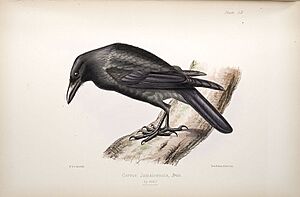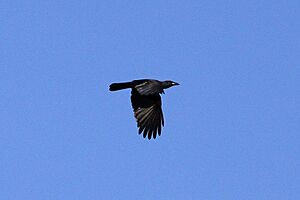Jamaican crow facts for kids
Quick facts for kids Jamaican crow |
|
|---|---|
 |
|
| Illustration by Philip Henry Gosse from 1849 | |
 |
|
| In flight, near Cockpit Country, Jamaica | |
| Conservation status | |
| Scientific classification | |
| Genus: |
Corvus
|
| Species: |
jamaicensis
|
 |
|
| Distribution map | |
The Jamaican crow (Corvus jamaicensis) is a cool bird found only on the island of Jamaica. It's a type of crow, but it's quite small, usually about 35 to 38 centimeters long. This crow is related to other crows in the West Indies, like the Cuban crow and the white-necked crow. They share some similar features.
Contents
About the Jamaican Crow
How the Jamaican Crow Got Its Name
People have known about the Jamaican crow for a long time. English naturalists like John Ray and Hans Sloane wrote about it in the early 1700s. They called it the "chattering crow." Later, in 1788, a German naturalist named Johann Friedrich Gmelin gave it its official scientific name, Corvus jamaicensis. This name helps scientists around the world know exactly which bird they are talking about.
What Does the Jamaican Crow Look Like?
The Jamaican crow has a unique look. Its feathers are a sooty-grey color and don't look shiny at all. It has a dark grey patch of skin without feathers right behind its eye. There's also a smaller bare patch of skin near the bottom of its beak.
Its beak is slate-grey and quite strong, ending in a sharp point. The feathers near its nose are thin, so you can often see its nostrils. The crow's eyes can be grey-brown or red-brown, which might depend on how old the bird is. Its legs and feet are black.
What Sounds Does It Make?
The Jamaican crow has a very special voice. It makes many different jabbering and bubbling sounds. This is why some people in Jamaica call it the "jabbering crow." It can also make a slower "craaa-aa" sound and other musical, burbling noises.
Where Does the Jamaican Crow Live?
As its name suggests, this crow lives only on the island of Jamaica. You can find it in forests that have some open areas. It also likes to visit larger gardens. While it mostly lives in hills and mountain forests, it sometimes comes down to lower areas. This happens more often during the dry season.
Jamaican Crow Life and Habits
What Does the Jamaican Crow Eat?
The Jamaican crow is a forest bird. A big part of its diet is fruit that it picks from trees. It often eats in pairs or small groups. It also looks for food under tree bark and in fallen leaves. There, it finds small invertebrates (like insects) and lizards. Sometimes, these crows will even take eggs or baby birds from other birds' nests.
Reproduction and Nesting
Jamaican crows usually build their nests high up in tall trees. They might also use holes in trees for nesting, but scientists haven't fully recorded this yet.
Images for kids



